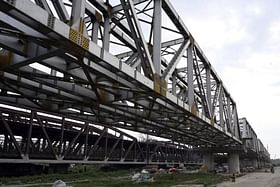The new bridge was planned to ease the burden on Loha Pul, but due to many roadblocks, the project kept getting delayed.
The existing Yamuna bridge, was built in 1867 and is a two-level structure. The lower level accommodates vehicular traffic, while trains operate on the upper level.
The new bridge will only be used for train movement, and the old one will remain operational for road traffic.
The construction of a new Yamuna bridge in Delhi is close to completion, according to senior officials of Northern Railway.
The new bridge, which runs parallel to the current one, was initially approved in 1997-98 and construction commenced in 2003. However, it has faced multiple delays over the past 20 years.
The existing Yamuna bridge, commonly known as Loha Pul, was built in 1867 and is a two-level structure. The lower level accommodates vehicular traffic, while trains operate on the upper level.
Unlike the old bridge, which has a speed restriction of 30 kmph due to it being overage, the new bridge will facilitate faster train speed, officials said.
The new bridge will only be used for train movement, and the old one will remain operational for road traffic.
A senior official of Northern Railway said that work on all 15 foundations had been completed, reports Times of India.
“Out of 14 spans, open web girders have been launched at six. For the remaining spans, fabrication work on the girders is in progress in a workshop. Other allied and finishing works will also be completed by September,” the official explained.
Two Decades Of Delays For the Bridge
The new bridge was planned to ease the burden on Loha Pul, but due to many roadblocks, the project kept getting delayed.
One of the major issues that delayed the construction work was the requirement of change in alignment of the bridge, owing to objections by the Archaeological Survey of India (ASI), as its original alignment was making its way through Salimgarh Fort, a protected monument, as per a Hindustan Times report.
To execute the bridge work, the railways needed to acquire land within the fort’s premises. However, in 2007, the ASI withdrew permission, citing potential damage to the protected monument if a portion of the wall was dismantled.
In 2011, a report from the Cultural Impact Assessment Committee led to a decision to change the alignment, avoiding the fort premises.
The ASI granted fresh permission in 2012 to the railways, considering the revised alignment and allowing the work to proceed.
After the new bridge is completed, the railways is planning to preserve the old structure as a heritage site. Alternatively, officials have mentioned the possibility of handing it over to the state government for the maintenance and operation of road traffic.


